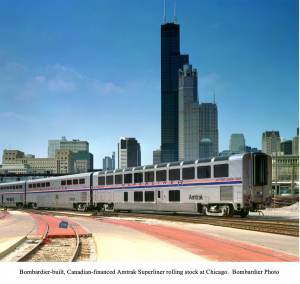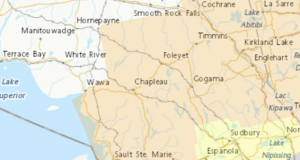 The recent performance by VIA Rail’s Canadian between Vancouver and Winnipeg – but not between Toronto and Winnipeg via Northern Ontario – on its first trip in nine months is the death rattle of Canada’s passenger trains. It needn’t be.
The recent performance by VIA Rail’s Canadian between Vancouver and Winnipeg – but not between Toronto and Winnipeg via Northern Ontario – on its first trip in nine months is the death rattle of Canada’s passenger trains. It needn’t be.
Working on my book on this long and sad Canadian saga, I frequently look south at Amtrak. There, a few miles from the border, a solution operates reliably, affordably, and effectively. It is the Chicago-St. Paul-Seattle/Portland Empire Builder. It is named for Ontario-born James J. Hill, who built the original railway plied by Amtrak’s double-deck train today using many Bombardier-built, Ottawa-financed passenger cars.
Amtrak and VIA started out at much the same place and with the same objective: Respond to public demands that the government save what remained of each country’s once-massive rail passenger systems. That happened in the U.S. in 1971 and it fuelled public demands that Pierre Trudeau’s government do the same here, which they reluctantly did in 1977.
But the similarities pretty much end right there. Amtrak faced rough political sledding through its 50 years of publicly-funded operation, but nothing like VIA. That’s because its founders armed it with enabling legislation that makes it almost impossible for any administration to kill it, though many have tried. That legislation allows Amtrak to adapt to changing conditions and adopt new concepts.
One key provision gives any state wanting more service the right to it if they pay part of the cost. That contrasts with Canada, where the provinces whine and contribute nothing to VIA while throwing billions at highways. The feds undermine their own VIA by propping up our overblown and expensive air system.
Amtrak’s 17 state partnerships fund 28 regional corridors in addition to its basic national network, which includes the high-density Northeast Corridor and 15 long-distance trains that make VIA look like a rolling museum.
Modern equipment has always been near the top of Amtrak’s agenda since its 1971 launch. Democratic and Republican legislators have made that happen. One was President-Elect Joe Biden, whose efforts in support of and daily use of Amtrak earned him the nicknames “Amtrak Joe” and the “Senator from Amtrak.”
Because of Biden and many other rail-savvy federal and state representatives before, during, and after his first tour on Capitol Hill, Amtrak rolls – and rolls with modern equipment that has slashed costs and boosted ridership and revenue.
The Empire Builder is typical of today’s coast-to-coast Amtrak network. In 2016, I compared it with VIA’s Canadian. Updating that analysis is virtually impossible because VIA frequently changes its data reporting methods. One might suspect VIA and its Ottawa leash-pullers are trying to hide something.
In 2013, Amtrak’s Empire Builder – equipped with double-deck Superliner cars, many built by Bombardier with Export Development Canada financing – carried more than five times as many passengers and ran more than twice as frequently for less than a third of the per-passenger subsidy of the Canadian, which operates with rebuilt 1950s rolling stock.
South of the Empire Builder’s route on the former Great Northern Railway – built by Ontario-born James J. Hill and the two Scottish cousins who also built the CPR – citizens and politicians are advocating the relaunch of the North Coast Limited on another line through Fargo, Bismarck, Billings, Helena, and Spokane. It would run in conjunction with the Empire Builder to link this aptly-named flyover territory with the Pacific Northwest and the Midwest.
There’s no reason Canada can’t do the same. Ah, but the politics of it all. That’s why VIA has been a disaster since its inception and is now clearly headed for that big roundhouse in the sky. We don’t have the equivalents of President-Elect Biden and the many other Democrats and Republicans who have seen the vital need for a modern rail passenger system to keep their nation economically, socially, and environmentally vibrant and competitive. It’s political will as much as public bucks that make the trains roll – or not.
Until that happens, Canada’s rail passenger service is doomed. It all makes me think of the words on that inspiring plaque beside the CPR main line at Craigellachie, British Columbia:
“A nebulous dream was a reality: an iron ribbon crossed Canada from sea to sea. Often following the footsteps of early explorers, nearly 3,000 miles of steel rail pushed across vast prairies, cleft lofty mountain passes, twisted through canyons, and bridged a thousand streams.
Here on November 7, 1885, a plain iron spike welded East to West.”
- A Northlander Fix or Fixation? Part 1 - May 5, 2022
- A Northlander Fix or Fixation? Part 2 - May 5, 2022
- The ACR’s Future – Sale or Abandonment? - January 16, 2021
 Wawa-news.com You can't hear the 'big picture'!
Wawa-news.com You can't hear the 'big picture'!
